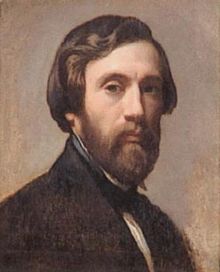Charles Gleyre
Marc-Charles-Gabriel Gleyre (born May 2, 1806 in Chevilly in the canton of Vaud , † May 5, 1874 in Paris ) was a Swiss painter .
Life
Charles Gleyre enjoyed an art education in Lyon and Paris, where he a. a. learned watercolor technique from Richard Parkes Bonington . He then went to Italy in 1828 , where he sought to penetrate the essence of the various schools and copied Giotto with the same care as Raphael and painted several historical genre pictures. From Italy he went in 1834 as a travel companion and draftsman for the industrialist John Lowell from Boston via southern Italy, Malta , Corfu and Turkey to the Orient and visited Egypt , Abyssinia and Syria . On his travels he drew sights, landscapes, costumes and folk scenes based on nature.
After he had to break off the trip to the Orient due to illness, he returned to Paris in 1838. Gleyre first appeared before the public in 1840 in the Paris Salon with the painting John on the island of Patmos . He achieved a resounding success in 1843 with the Le Soir (evening) , a motif from the Nile that depicts a poet who sees the personified dreams of his youth sailing away in a boat from the shore (also called Les illusions perdues - The lost illusions ).
From then on he found his own way by combining the power of expression and depth of feeling with poetic ideality. He painted religious, historical and mythological pictures, combining the latter with a romantic mood with the strict, stylish formal language of antiquity .
Major works
- La rein de Saba / The Queen of Saba (1839)
- The separation of the apostles (1845 in the church of Montargis )
- The Nymph Echo (1846)
- La danse des Bacchantes (The Dance of the Bacchantes ) (1849)
- Le Majeur Davel (The Death of Major Davel ) (1850; destroyed in a fire in 1980)
- Boaz and Ruth
- The triumph of Helvetiers Divico over the Romans (1858)
- Heracles and Omphale (1863)
- Pentheus persecuted by the maenads (1864)
- The Sorceress (1868)
- Sappho goes to bed (1867)
- Visite de la Reine de Saba (Visit of the Queen of Sheba) (1871–1875)
Picture gallery
Three fellahs (1835)
The Major Davel before his execution (1850)
Le Soir ou Les Illusions perdues (1843), Musée du Louvre , Paris.
student
Gleyre was one of the first idealists in French art outside the school of Ingres , and became a well-known teacher; in his studio a . a. Félix Thomas , Jean-Léon Gérôme , Albert Anker , Jean-Louis Hamon , Jean Lecomte du Noüy , Auguste Toulmouche , Edward Poynter , Claude Monet , Pierre-Auguste Renoir , Frédéric Bazille , Daniel Ridgway Knight , Alfred Sisley and James McNeill Whistler .
annotation
- ↑ buried first on Montparnasse , then in Chevilly, then his remains transferred to the La Sallaz cemetery in Lausanne , then erection of a cenotaph at the village church of Chevilly (today with incorrect inscription: Les cendres de Gleyre sont deposées ici. )
literature
- Charles Gleyre. Le génie de l'invention. Exhibition catalog. Musée cantonal des beaux-arts de Lausanne , 2006.
Web links
- William Hauptman: Gleyre, Charles. In: Historical Lexicon of Switzerland .
- Publications by and about Charles Gleyre in the Helveticat catalog of the Swiss National Library
- William Hauptman: Gleyre, Marc-Charles-Gabriel. In: Sikart
- Charles Gleyre In: E-Periodica
| personal data | |
|---|---|
| SURNAME | Gleyre, Charles |
| ALTERNATIVE NAMES | Gleyre, Marc-Charles-Gabriel (full name) |
| BRIEF DESCRIPTION | Swiss painter |
| DATE OF BIRTH | May 2, 1806 |
| PLACE OF BIRTH | Chevilly , Canton of Vaud |
| DATE OF DEATH | May 5, 1874 |
| Place of death | Paris |






